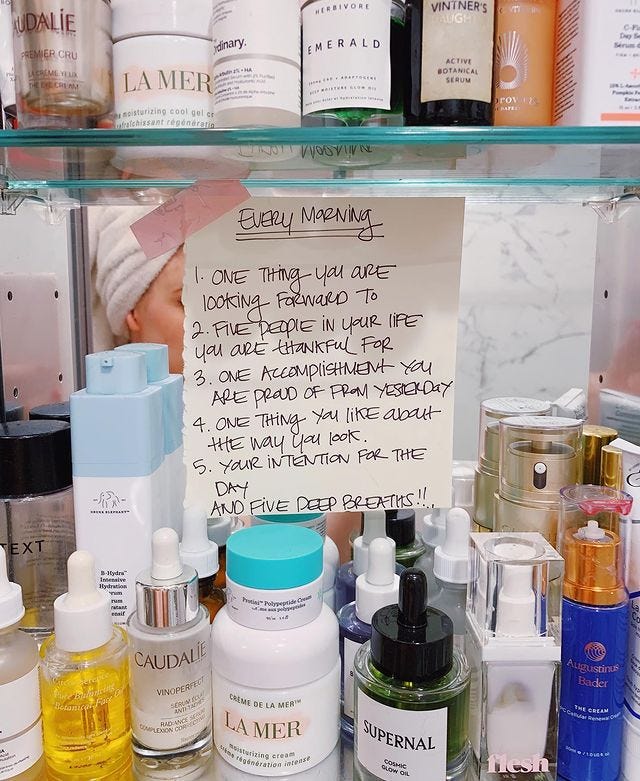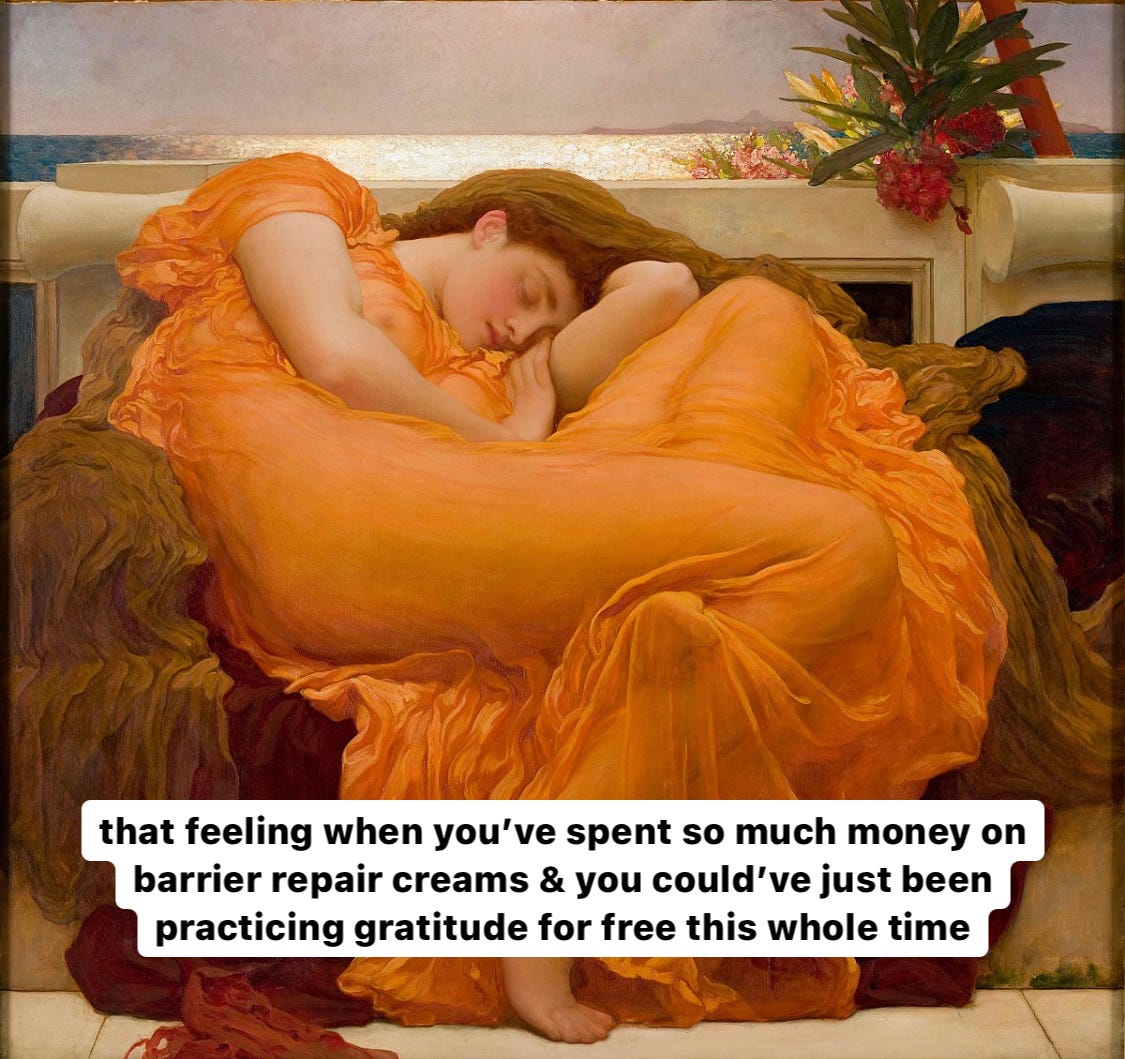Have you thanked the universe lately? I highly recommend it. For one, it’s a Nice Thing To Do for the ever-expanding assemblage of space and matter that supports your very existence. But also, gratitude is cool now. Just ask Chanel’s official brow artist, or the founder of cult-favorite beauty brand Summer Fridays, or celebrity-loved skin expert Dr. Murad.
Yes, like many spiritual tools before it — crystals, reiki, meditation — the beauty industry has glommed onto gratitude. The always-wet-looking Emily Weiss, CEO of Glossier, keeps a gratitude journal; perhaps the real secret to her moistness? Allison McNamara, dewy influencer and founder of MARA Beauty, starts her day by gratitude journaling, too. When poet Cleo Wade dropped her skin-care routine on Allure, she included staying present, practicing self-love, and being grateful for good moisturizer.
“I absolutely consider gratitude to be a part of my personal beauty routine,” says influencer Christina Grasso (@thepouf). She’s posted multiple pictures of her unconventional shelfie set-up over the years, featuring the expected and expensive skin-care suspects — La Mer, Vintner’s Daughter, The Cream from Augustinus Bader — but also, a handwritten morning ritual taped to the bathroom mirror with directives like “List five people in your life you are thankful for” and “Set an intention for the day.” It’s an unwitting example of the consumer-friendly “consciousness” that dominates Western wellness culture; a head-on collision of skin-care and self-care; the epitome of modern “mindfulness.”
Or, considering the hundred or so curious comments underneath — “damn okay doing this,” “copying pronto,” “stealing this idea!” — Intro to Inner Glow for the masses.
Grasso “absolutely” considers gratitude part of her skin-care routine, she told me in an interview for The Cut in 2020.
“I am lucky enough to have a very well-stocked beauty cabinet through generous giftings and collaborations,” she says, “but no product will buy happiness or true self-confidence, and a clear complexion won’t either, though it certainly doesn’t hurt.” She calls her products “supplemental,” and believes “doing the inner work, of which gratitude is a part for me, is paramount.”
That inner work is all out there on her Instagram, where Grasso regularly posts shots of lipstick-scribbled affirmations: “Everything is going to be OK,” and “Happiness depends on your attitude, not on what you have.” She says she was introduced to affirmations about a decade ago while in treatment for an eating disorder. “I probably — definitely — scoffed at the idea initially.”
The influencer is not alone in her scoffing. For all the industry’s merging of skincare and spirituality, the latter still tends to get the side-eye (when, ahem, the former deserves it). But there’s evidence to suggest mindfulness practices boast more benefits than any pre-bottled product, for the mind and moisture barrier both.
Studies show affirmations increase brain activity in areas associated with reward and valuation, and can even influence future positive behavior. As Grass explains it, “The neural pathways that enabled my illness had been formed by years of repeated thoughts and behaviors, and I had to work to create new ones in order to survive, which required a lot of opposite action and encouragement from others and myself.”
Dr. Howard Murad, pharmacist and founder of Murad Skincare, says affirmations can even affect your skin. In addition to his brand’s popular Replenishing Multi-Acid Peel and AHA/BHA Exfoliating Cleanser, the doctor offers the Dr. Murad’s Inspirations app. Download it, and a daily push notification presents one of 11 positive affirmations. His favorite: “Why have a bad day when you can have a good day?”
“The 11 affirmations I recommend today are based on a clinical study that produced positive, measurable results related to stress reduction,” Dr. Murad says. That stress reduction affected better sleep, which affected better skin. After “just eight weeks of saying these 11 affirmations twice a day and journaling for five minutes,” subjects saw “reduced fine lines, dark circles, and redness,” Dr. Murad says. (With results like these, why even bother with the acid peel?)
Add gratitude to the equation, and study results skyrocket. One research paper from 2015 showed that a simple gratitude exercise — in this case, writing a letter of thankfulness — not only lowered anxiety and depression in the moment, it lowered them long-term, too. Participants were still “hardwired” to feel more grateful and less stressed months later, and although their appearance wasn’t evaluated, one can only assume they were positively radiant, right? Right. In theory.
“Anything that lowers stress levels improves the health of the skin,” says Dr. Amy Wechsler, a psychodermatologist (that’s double-board-certified in psychiatry and dermatology) who studies the mind-skin connection.
Plenty of research on the Skin-Brain Axis can vouch for that, as can Summer Fridays co-founder Lauren Gores Ireland. “When we are grateful, there’s a certain light that exudes from our eyes, and when we’re in a rut, it’s as though our faces look foggy,” she tells me. “The inside work manifests into a whole new kind of glow that even the best highlighter in the world can’t give you.” Sadly, her Jet Lag Mask can’t deliver that either, so Gores Ireland keeps a gratitude journal. She spends a few minutes each day documenting what she’s grateful for or looking for the positives in a negative situation. “I usually journal prior to my nighttime beauty routine,” the entrepreneur shares; but according to Dr. Wechsler, gratitude is the beauty routine.
“When someone is feeling great and happy, it shows on their face [because] the skin's barrier function is working better,” the psychodermatologist says. Stress causes the barrier to weaken and “leak” water, and practicing gratitude — by lowering levels of stress, anxiety, and depression both short-term and long-term — literally helps it “stay hydrated, turn over cells healthfully, and overall have a brighter appearance.” The metaphorical “lit from within” look, then, is not so much metaphoric as scientific.
This is a nice explanation, and a convenient one. But is there something deeper at play here? Something more spiritual than skin barrier function and stress levels? Lalah Delia, certified spiritual practitioner and author of the just-released Vibrate Higher Daily, thinks so.
“The inner and outer can be a reflection of each other — sometimes our blemishes and things on the outside are because something on the inside is processing,” Delia tells me at the Create & Cultivate Self-Care Summit in Los Angeles. Acne may represent a deeper issue around being seen; dull skin could result from ignoring your soul’s purpose. “Wherever that energy shows up, it’s just a matter of putting more love more grace there, raising your vibration, and allowing yourself to show up for that part of yourself,” the author says. How you show up is up to you: You can meditate, or treat yourself to a massage, or repeat a mantra, of which Delia offers many on Instagram. “When you are in a state of deep gratitude and vibrating hard, it shows,” she explains. “You know what I mean?”
I do. I discovered the whole gratitude-as-skin-care thing about three years ago, after my skin was maybe permanently thinned by a topical steroid prescription. (The standard treatment window for steroids is two weeks; I was on them for two years, which caused a condition terrifyingly known as “skin atrophy.”) My face can’t handle much more than pure Mānuka honey and jojoba oil, so I’m constantly searching for ways to heal from the inside out — meditation, deep breathing, eating seeds, orgasming. I also give thanks to my skin.
The metaphorical “lit from within” look, then, is not so much metaphoric as scientific.
I start my morning meditation by taking a few deep breaths and saying, in my head, “Thank you, skin.” I think about how everything my skin does is literally meant to protect me, and try to find the positive in the perceived “flaw.” Sensitive skin becomes communicative skin: “Thank you, skin, for communicating with me every day and guiding me to make the best choices for my health and well-being.” Acne scars become a sign of healing in progress: “Thank you, skin, for being so resilient.” Pimples become an elimination technique: “Thank you, skin, for working so hard to get that gunk out.” I repeat these on a loop in my head for a few minutes, until I settle into a more traditional meditation.
It’s a simple shift in perspective, but it helps me see my skin through a lens of love, rather than a lens of judgement. Instead of lamenting it, I celebrate it. Instead of stressing about what I look like, I look for the deeper message — usually, to stop basing my self-worth on what I look like. (Touché, universe.) My skin has healed so much since incorporating gratitude. Plus it feels good and costs nothing.
As Grasso says, “Capitalism is nice” — [Editor’s Note: It is not] — “but gratitude works, too.” Don’t overlook the scientifically-proven, barrier-repairing power of saying “thank you” to the universe, or even just to your skin.






I absolutely agree! Years ago I started implementing deep breathing, meditation and affirmations in my facials and home care for my clients and those who did it had incredible results. All with very minimal supportive skincare (obviously 😉)
I adore the trajectory of this piece. Gratitude is truly more important than anything we can put on our skin.